|
HORTICULTURE
Bountiful harvest:Tissue culture banana cultivation
Record Break:Continuing success of precision farming in Tamil Nadu
Growing muskmelon as precision crop is highly profitable
Rosemary shows the way to keep wild animals at bay
Rumani mango: a farmer's efforts bear fruit
Drip fertigation boosts yield in banana cultivation
Bountiful harvest:Tissue culture banana cultivation |
|
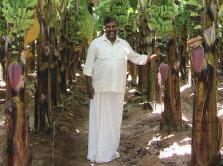
Farmer in his banana field
Banana cultivation has always taken a back seat in crop preference in Tamil Nadu as only a few farmers are bold enough to grow the crop in large areas. Though there are many reasons such as strong winds (the plant falls down during strong winds), heavy rainfall or monsoon failure attributed to this, absence of proper marketing channels appears to be the main reason for many farmers to move away from banana crops. But farmers of Theni, Chinnamanur, and Uthamapalayam regions of Tamil Nadu have a different story to tell. They grow the crop in a minimum of 2-3 acres and are fully satisfied with the returns. These farmers mainly grow tissue cultured (TC) Grand Naine banana variety.
Grand Naine is popular because it has a relatively good shelf life, is an attractive golden yellow in colour at maturity and is internationally acceptable, both as a fresh fruit and in processed form, according to Mr. S. Narayanan, Vice President, Marketing, Jain Irrigation Systems Ltd, Coimbatore .With an initial investment of Rs. 80,000-85,000 per acre these farmers get a yield of 38-40 tonnes per acre which amounts to Rs. 1,50,000-1,60,000 per acre as gross income and a net income of Rs.70,000 -75,000 per acre annually.
Farmers are advised to go in for two ratoons, which gives them a net income of about Rs. 1 lakh each, per acre. Thus in about 27-30 months, with intensive cultivation, farmers can get a net income of Rs. 2.25 to 2.50 lakhs per acre, according to Mr. Narayanan. “The TC planting material costs Rs. 12 per plant from us and we make sure that it is delivered at the farmer’s site anywhere within Tamil Nadu. The cost of establishing drip irrigation system in an acre comes to Rs. 20,000 -25,000 which can be recovered in the first crop itself,” said Narayanan.
Planting distance
The field must be ploughed well and furrows formed six feet apart, and planting should be done at a distance of 5-6 feet apart in each furrow. Planting is done at a depth of six inches in the furrows. Required quantities of organic manure, 5 gms of phorate and 200 gm neem cake are applied in each pit.
Watering immediately and thereafter is done through drip irrigation. Fertigation starts from 10th day onwards and a detailed fertigation schedule is provided to each farmer, he said. The plants are earthed up twice till up to the 75th day up to a height of 1.5 to 2 feet from the ground level. All these farmers have adapted well to the use of in-line system of drip irrigation, which provides a kind of strip wetting all along the plant row directing the root growth along the wet area. With the tendency of banana roots to grow as long as 1.00 metre and more, quite early, strip wetting helps in feeding the roots better, which in turn gets converted into active plant growth and performance, explained Narayanan.
Ratoon management
Keeping the field and neighborhood free of weeds generally is advised to avoid spread of infestations. Though the TC plants, which are supplied are generally healthy and virus free, field contamination can be avoided only by keeping the field free of weeds. Ratoon management is important for sustained income. In a place like Theni, three ratoons have been done in 24-25 months.
Once the flowers emerge and all the fruits have fully opened, the bunches are covered using a “skirting bag” which prevents the tender fruits from insect attack, besides maintaining uniform temperature inside. “This is important for colour and fruit development,” he said.
Value addition
The farmers have also standardized the harvesting and packing methods locally, according to Mr. Narayanan. This value addition has a ready market in metros like Chennai and Kochi besides Coimbatore, Madurai, and other markets in Kerala. The price realization is quite high (at present the fruits are sold for about Rs. 10 - 11 per kg at Koyambedu market in Chennai). The farmers have already sent consignments to Mumbai and Kolkata.
Word of caution
But Mr. Narayanan has a word of caution for those interested in growing this variety, suggesting visit the farmers’ fields at Theni, Chinnamanur, Uthamapalayam to get first hand information.
With Indian agriculture, particularly, horticulture, set for a take off, and with retail chains showing interest, the future looks bright especially for grand naine banana cultivators.
Contact details: Mr. S. Narayanan, Vice President-Marketing can be contacted at Jain Irrigation Systems Ltd, New No. 126 - West Ponnurangam Road, R.S Puram, Coimbatore- 641-002, email: narayanan@jains.com, phone: 0422-2540365, mobile: 94433-16061.
Record Break:Continuing success of precision farming in Tamil Nadu |
|
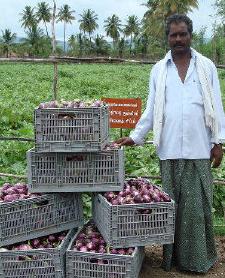
Mr. Chinnasamy of Tamil Nadu with his harvested brinjals.
New innovations and technologies for increasing crop yield have mostly been the fort of agricultural scientists and researchers. Precision Farming Technology is one such innovationthat has been introduced for the first time in the country by scientists from the Tamil Nadu Agricultural University (TNAU), Coimbatore. Precision farming promises to increase the yield of crops, and practically any crop variety can be cultivated under this system.
Very popular
Presently this project is meeting with large success in many districts of Tamil Nadu. Those farmers, already under this project, have surrendered their success in terms of yield and marketing to this technology.Unlike certain other technologies which teach or guide the farmer to grow his cropsbut leave himto market hisown produce, precision technology scientists stay with the farmers right from sowing the seeds to marketing the produce.
Marketing made easy
The research team identifies prospective buyers in and around the area andbinds the farmer and the buyer in a sort of contract agreement, and oversees the entire operation. Mr. P.M. Chinnasamy is one such precision farmer from Somenahalli village who has earned more than Rs. 5 lakh from his brinjal crop grown in 120 cents in about 11 months.
“A progressive farmer can get only 60 tonnes per hectare whereas Mr. Chinnasamy has harvested about 170 tonnes in 120 cents, which is quite a feat. “It is 467 per cent higher than the conventional system of cultivation,” said Dr. Vadivel, Director of Extension Education, and TNAU. Giving details he said, the seeds were sown in protrays raised under shade net and transplanted on the 35th day after sowing.
Field preparation
The field was prepared by using chisel plough first, followed by disc and cultivatorsfour times. Before last ploughing, a basal dose of 700 kg of super phosphate, 25 tonnes offarmyard manure along with Azospirillum and Phosphobacteria each at 2 kg per hectare was applied.
Raised beds of 60 cm width were formed and the seedlings planted on the centre of the raised beds at a spacing of 45 cm.
Wastage avoided
Under the conventional system 23,000 plants are required for planting.But, forprecision farming system, only 14,500 plants are required.
Fertilizers were given only through fertigation, which avoids wastage through flood irrigation.
All water soluble fertilizers were applied based on the time and the stage of the crop.
The plant growth was found to be good,and thiscontinued till the last harvest. Due to the continuous growth and flowering, harvesting was done once in two days. The flowering is mainly due to continuous supply of fertigation and constant absorption of nutrients.
Extended crop life
Brinjal is a six month crop but under precision farming the duration can be extended up to one year. It is an advantage over the traditional system since the extension of harvest increases the productivity, according to Dr. I. Muthuvel, Assistant Professor, Horticulture of the University. The main pests were fruit borer that was controlled effectively spraying monocrotophos or chloripyriphos at 2 ml per litre of water, and in later stages Indoxacarb at 0.5 ml per litre of water, according to Dr. Muthuvel.
Attractive fruits
Diseases such as blight and fruit rot were controlled by spraying mancozeb at 2 ml per litre of water. The fruits are quite attractive and the shelf life is more compared to that grown under conventional system. Mr. Chinnasamy has so far harvested 170 tonnes and has sold them for Rs. 5 -15 a kg.
Contact details: Dr. I. Muthuvel, Assistant Professor (Horticulture), TNAU, Coimbatore, email: muthu_hort@yahoo.co.in, mobile: 9443715948 and Mr. P. M. Chinnasamy, Somenahalli, Dharmapuri district, Tamil Nadu.
Growing muskmelon as precision crop is highly profitable |
|
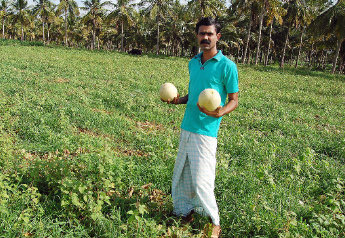
More yield: The farmer Mr. C. Boopathy of Dharmaputi district in Tamil Nadu has harvested about 45 tonnes of fruit from an hectare.
Muskmelon is a fruit crop cultivated widely by farmers in our country particularly during the summer season. The fruit is used for making sherbets and desserts which have a cooling effect on the body.
Though it is mainly a summer crop it is now being cultivated throughout the year in Tamil Nadu, thanks to the Precision Farming technology from the Tamil Nadu Agricultural University (TNAU), Coimbatore, Tamil Nadu.
Mr. C. Boopathy, a beneficiary farmer of the precision farming technology (PFT) in Morappur village of Dharmapuri district in Tamil Nadu has grown musk melon in his one hectare farm.
Net profit
“I had spent about Rs. 90,000 as cultivation cost and was able to get a gross income of Rs. 3,60,000. Deducting the expense I have earned a net profit of Rs. 2,70,000 solely from musk melon,” he says.
The seedlings are raised in protrays which are filled with cocopeat and grown in a shade net nursery under protected condition. They are ready for transplanting in the main field on 12th day of sowing, according to him.
Healthy plants
The root growth is excellent when the seedlings are grown in protrays and the seedlings are resistant to pests and diseases. All the plants are uniform, healthy and the portrays can be easily taken to the main field for transplanting, according to Dr. E. Vadivel, Director, Extension Education, TNAU.
About 20,000 seedlings are required for planting in one hectare.
The field was readied using a chisel plough and disc (once) and then by cultivators, four times (with the help of a tractor). Then the seedlings were planted on raised beds of 1x4 feet (one foot height and four feet wide beds).
About 25 tonnes of farm yard manure (FYM), 2 kg of biofertilizers such as Azospirillum or Phosphobacteria and 470 kg of super phosphate were applied (for one hectare) as a basal application before the last ploughing.
Water soluble fertilizers were applied through fertigation pipes (similar to drip irrigation pipes) which avoid water wastage. The fertilizer application is done based on the time and the stage of the crop.
Unlike crops grown under the conventional system, precision crops come to harvest at an earlier stage. For example, this melon was harvested on the 65th day after planting.
Uniform fruit growth
Under normal practices harvesting can be done after the 75th day after planting. In addition there are more number of flowers in the plant and the fruit growth is also uniform, according to Dr. R.I. Muthuvel, Assistant Professor, Horticulture.
Also, the fruits can be harvested in a single harvest unlike conventional system where 3-4 harvests are required.
Major pests affecting the crop are beetles, white flies and fruit borers. Beetles and white flies can be controlled by spraying 2gms of Carboryl or 0.5 gms of Acetamopride diluted in one litre of water. Spraying 2 ml of Trizophos or 2gm of Thiodicarb or Methomil in one litre of water is found effective for the control of fruit borers.
The fruit weight is also more compared fetches a good price in the market due to higher sweet content and shelf life, according to Dr. Muthuvel.
“I was able to harvest two fruits from a single vine he said. Each fruit weighed 1.25 - 1.5 kg. About 45 tonnes of fruit was harvested from a hectare and sold at Rs. 5 to 12 a kg,” said Mr. Boopathy.
Contact details : Dr. I. Muthuvel, Assistant Professor, Horticulture, TNAU, Coimbatore: 641 003, Tamil Nadu, mobile: 94437-15948 and Mr. C. Boopathy, Morappur village, Dharmapuri district, Tamil Nadu.
Rosemary shows the way to keep wild animals at bay |
|
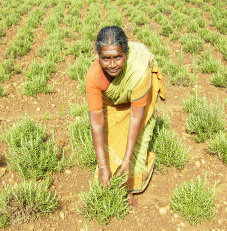
Saved by scent: Mrs. Puttiyamma, tribal lady farmer of Bargur hills in
Erode district of Tamil Nadu in her Rosemary field.
Experiencing unexpected losses in agriculture due to adverse climate or pest attack is a common feature in the life of farmers. Even the best technologies fail when they have to gamble with adverse climate. The problem is all the more acute for those living in hilly regions bordering reserve forest areas.
Crop and life loss
Because apart from the vagaries of climate, farmers also have to keep track of movements of wild animals in their fields which cause sudden and disastrous loss both to the crops and sometimes to human lives.
Mrs. Puttiyamma, is a tribal lady farmer of Bargur hills in Erode district of Tamil Nadu who has successfully proved that all the above stated facts are not a deterrent when it comes to growing crops in the hills and successfully marketing them.
Casual jobs
Mrs. Puttiyamma owns about 4 acres of land and is presently growing Rosemary in about half an acre. “I was growing ragi and double beans and reaped only a minimum margin. With no alternative I was forced to seek other casual jobs to meet my family’s basic needs. “It was then that I heard from sources in my village about MYRADA KVK (Mysore Resettlement and Development Agency Krishi Vigyan Kendra) which has been encouraging farmers in our area to grow Rosemary (an aromatic herb) and are also helping them to market the produce through the Rosemary Group (created mainly for farmers growing Rosemary),” she explained.
She has joined in the Rosemary Growers Group three years ago and started cultivating the crop. Rosemary thrives well both in irrigated and dry land conditions and is not disturbed and grazed by any wild animal because of its aroma.
As it is a perennial crop there is no need for investing money for seeds and land preparation every year and the crop provides a stable income.
Income details
Mrs. Puttiyamma has so far harvested about 2,898 kg of fresh leaves and has earned about Rs.11.00 per kg of fresh leaves in the past three years.
“I have so far earned about Rs.31,878 in 3 years from 1/2 an acre of land under rainfed condition whereas the returns from rest 3.5 acres of Ragi crop and beans have been only Rs.17,500. My income kindled the interest of other farmers who also started growing the crop,” she said.
Oil extraction unit
As there has been an increase in the number of farmers who have taken up Rosemary cultivation the District Rural Development Agency, Erode, has funded for establishment of an oil extraction unit nearby.
The unit has reduced the herbage loss during transport and has been able to increase the income to about Rs.2,000 per acre besides providing employment to the rural youth.
The tribals of this region were mainly growing crops such as ragi, double beans, turmeric and some fruit varieties. But due to constant incursion by wild animals from the bordering reserve forests many of them were not able to succeed in their farming operations, explained, Mr. P. Alagesan, Programme Co-ordinator, Myrada Krishi Vigyan Kendra.
Aromatic crops
“When some of the tribals approached us for guidance our team visited the area and after careful study realized that aromatic crops can be safely grown there as the climate is cool and favourable and also the fragrance emanating from these aromatic plants will keep the wild animals at bay,” he said.
The tribals were made to interact with officials of the HOPE IN NILGRIS organization in Udhagamandalam who were already pioneers in the cultivation and promotion of Rosemary crop.
After the exposure visit, the farmers showed more interest and involvement in the cultivation of Rosemary. Mrs. Puttiyamma was conferred the ‘Velanmai Chemmal’ award by the TNAU in 2006.
At present more than 100 acres of the hilly region have come under this crop cultivation. Information and training to the tribals were arranged by Myrada-KVK.
Contact details : P. Alagesan, Programme Co-ordinator, Myrada Krishi Vigyan Kendra, No- 57 - Bharathi Street, Gobichettipalayam - 638 452, Erode district Tamil Nadu, e-mail : myradakvk@dataone.in, website: www.myradakvk.org, Phone : 04285 226694, 226695.
Rumani mango: a farmer's efforts bear fruit |
|
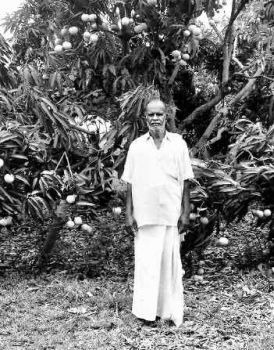
Mr. Veerabhadran, a mango farmer in Mampakkam village in Tamil Nadu in his orchard.
MANGO IS a biennial bearer. The tree gives good yield in the first year, which slightly declines in the ensuing year.
Though the tree grows well in a variety of soils, with proper fertilizer applications and good irrigation techniques, the tree can be made to bear fruits every year.
Mr. P. Veerabhadran, a farmer from Mampakkam village, Chengalpattu district, Tamil Nadu is a mango farmer who has planted both Banganapalli and Rumani mango varieties in his 0.7 hectares land.
Water shortage
"A decade back I was growing crops such as paddy and vegetables," he said. "Because of severe water shortage and successive monsoon failures I lost a major portion of my crop. "To overcome this problem, I thought of planting alternative crops, which would require less water unlike paddy and decided to plant mango in my field.
At present I have about 250 Banganapalli and 400 Rumani varieties planted in my field. Both the varieties are able to fetch me a tidy income every year," he said.
Growing intercrops
"For the first four years after planting the mango seedlings, I grew a variety of intercrops such as vegetables and groundnuts to supplement income.
After harvest the intercrops were ploughed into the soil as green manure," he said. The fruits were plucked only from the fifth year. He had procured the grafts from a local farm and had planted them at a spacing of about 6 feet in straight lines.
Before planting, the land was ploughed well by mixing rotten farmyard manure.
About 3 cubic m pits were dug and three-fourth of each pit was filled with about 20 kg of farmyard manure.
The mango seedlings were planted in a way that the grafted portion was above the soil surface and the pits were closed with sand and irrigated.
Irrigation was mainly done from a tube well and the young seedlings were irrigated once every 5 days. After 3 years of planting, irrigation was done once every 15 days, according to Mr. Veerabhadran.
Regular manuring
The trees were regularly manured during August-September every year with liberal quantities of well rotten farmyard manure and neem cake.
Other common practices required for mangoes such as pruning the shoots below the grafted portion, weeding and ploughing the interspaces were also done.
For the first 3-4 years the trees were not allowed to flower and if flowering was noticed it was removed manually, Mr. Veerabhadran explained.
To protect the trees from pests such as fruit fly and fruit borer, the farmer adopted an indigenous plant protection method.
A paste made from the leaves of Neem, Adathoda, Pungai, Nochi, and Perandai (Tamil names) was soaked in cow's urine for 15-20 days.
After 15 days the solution was filtered and then diluted in water (1ml of the paste in 10 ml of water) and sprayed over the crown of the trees.
Panchagavya spray
The fruits were allowed to ripen from the fifth year of planting.
When the trees started flowering in the fifth year, liberal quantities of diluted Panchgavya were sprayed over the crown, and on the trunks of the trees.
Farmyard manure and powdered neem cake were added around the base at a distance of about two feet of the tree trunk in circular pits during the monsoon, explained Mr. Veerabhadran.
Total expenditure
"I had spent about Rs 15,000 per hectare for growing, harvesting the intercrops, tree maintenance, and labour. I am expecting a harvest of 8-10 tonnes of Rumani fruits this year," he said.
Rumani mangoes come to the market usually at the end of the mango season and fetch a good price when most of the other varieties lapse.
Contact details: Mr. P. Veerabhadran, Mampakkam village, Kanchipuram district, Chengalpattu taluka, Tamil Nadu 600-048, phone: 044-27479090.
Contract farming of Coleus forskholii gaining popularity |
|
CONTRACT FARMING of Coleus forskholii is gaining popularity among small and marginal farmers of Kanchipuram district in Tamil Nadu. Coleus forskholii is a short term medicinal plant. The suckers of the plant contain an ingredient called Forskholin, which is used in the preparation of several ayurvedic medicines.
In India, about 2,500 tonnes of Coleus forskholii are cultivated annually. The crop is widely grown in Gujarat, Karnataka and Tamil Nadu. Coleus forskholii is known as Marundu koorkan in Tamil, Coleus in English, Padarsoor in Hindi and Magandhiperu in Kannada.
Less water requirement
The crop is not water intensive and needs to be irrigated only once in 10 days. Therefore, it can be grown in an area, where water availability is not abundant.
The plants grow to a height of 2-3 cms. The sucker resembles a carrot in shape and is light yellow in colour.
The ideal seasons for growing this crop are June-July and September-October.
Profitable crop
"It is an easy to grow and a profitable crop for the farmers," said Mr. C. Perumal, retired agricultural officer and coordinator for more than 30 farmers who are growing this crop in Kanchipuram district.
The planting material (suckers) and technical guidance along with a cash advance are given by the concerned agency, which promotes the crop.
The contract procedures are quite simple, and the market is well assured. Mr. Perumal explained.
The plant grows well in a variety of soils. Being a hardy crop, free from any major pest and diseases, it can be grown with minimum care and investment.
Mr. Chinnapayan, a progressive farmer of Musarawakkam village in Kanchipuram district, has been growing Coleus forskholii in his 1.5 hectares for the past three years. About 1,00,000 suckers have been planted in his 1.5 hectares land.
Giving details on the planting technique Mr. Perumal explained, before planting the suckers, about 40 tonnes of rotten farmyard manure, three bags of DAP (Di-ammonium-phosphate) and six bags of neem cake were applied and the field was ploughed into furrows and irrigated.
Spacing details
The suckers were then planted at a spacing of about 2 cm on the furrows in a straight line. Irrigation was done on the third day after planting and continued once every 10 days.
Three side dressings of about 60 kg of potash and 100 kg of vermicompost were applied on the 45th, 90th and 135th day of planting. "Farmers are advised to tighten the soil around the roots of the plant every time when the side dressing is done," Mr. Perumal said.
Weeding time
Weeding has to be done once every 25 days and as required. Though the crop is quite resistant to pest infestations, Mr. Chinnapayan's crop was found to have been infested with leaf mosaic virus.
To control this infestation, he was advised to spray Bavistin 500 gms diluted in 200 litres of water twice in the mornings, according to Perumal.
Harvesting schedule
The crop comes to harvest in about six months after planting and from one hectare about 12 tonnes of coleus suckers can be harvested. Fresh suckers are sold at the rate of Rs. 4.50 per kg.
Mr. Chinnapayan said, "I have spent about Rs. 25,000, which includes cultivation, fertilizer and harvesting cost and am expecting a gross income of about Rs.55,000.""After deducting the cultivation expenses, I am expecting a net income of about Rs.30,000 ," he said.
Contact details: Mr. C. Perumal at 99940-91891 and Mr. Chinnapayan at Musarawakkam village, Kanchipuram district, 631-502, Tamil Nadu.
Drip fertigation boosts yield in banana cultivation |
|

Mr. Venkatesan, banana farmer of Dharmapuri having a look at his crop, which is ready for harvest.
Research at the Tamil Nadu Agricultural University (TNAU), Coimbatore, have implemented state sponsored precision farming through drip fertigation project in Krishnagiri and Dharmapuri districts of Tamil Nadu. The project costs Rs.10 crore and covers about 400 hectares in the districts.
This project is a boon to all farmers in these two districts who have been cultivating vegetables such as tomato, bhendi and cavendish banana varieties.
Equal weight
All the crops attain uniform height and fruits and vegetables attain equal weight when grown under fertigation system (application of water soluble fertilizer through drip irrigation), according to Dr. I. Muthuvel, Assistant Project Officer, Tamil Nadu Precision Farming Project, Dharmapuri.
The technology, in addition to conserving water, has also helped in good growth of the crops, according to Mr. M. Venkatesan, a beneficiary farmer in the district who is at present cultivating G-9 cavendish banana variety in his one hectare land.
About 25 hectares are at present under banana cultivation in Dharmapuri district, according to Dr. Muthuvel.
Saving water
"Precision farming has helped me obtain uniform banana bunches with even ripening and saved as much as 50 per cent water compared with the conventional system where water was allowed to flow in furrows in the fields," said Mr. Venkatesan.
Giving details on field preparation, Mr. Venkatesan said, about 2 kg of super phosphate, 200 gm of gypsum, 20 gm of furidon and 5 kg of farmyard manure were applied to the field and ploughed well.
Raised beds of about one foot in height were prepared. Cubical pits of about 2 cubic feet were dug on the raised beds and the suckers were placed inside the pit and covered with soil and watered immediately.
Fertigation was done once every five days. About 3,000 suckers are needed for planting in one hectare, according to Mr. Venkatesan.
After two months of planting, emerging side suckers were manually removed. Side suckers have to be removed as and when noticed.
Only one side sucker can be allowed to grow in the eighth month and the rest removed, explained Dr. Muthuvel.
In the seventh month, stakes were tied to the trees to prevent them from falling due to heavy wind or rains. The variety was found susceptible to erwina rot infestation.
Drenching the base of the plant with about 1 gm emisan solution diluted in a litre of water was found effective in controlling this infestation.
Yield statistics
The first bunch of fruits appear sometime during the eighth month after planting. During this time it is advisable for farmers to spray polyfeed over the fruit bunches to obtain uniform weight and growth.
About 100 tonnes of fruits were harvested in the eleventh month after planting and sold at Rs. 8,000 per tonne. "I expect to harvest the first ratoon crop in the 21st month and the second in the 30th month," said Venkatesan.
The main advantage of using fertigation technique according to Dr. Muthuvel, is that "all the bunches from the three crops will be almost uniform in size and weight."
Irrigation cost
Bunches from the planted crop weighed 30-32 kg each. The cost of the drip system worked out to about Rs.1.15 lakh per hectare. "I had purchased the suckers at a cost of Rs. 11 per sucker and have spent about Rs.1 lakh towards cultivation expenses," said Mr. Venkatesan.
Contact details : Mr. Venkatesan can be contacted at Poduthampatti Post, Kuddampatti village, Somanahalli, Palacode Taluka, Dharmapuri district, Tamil Nadu.
Contract farming of Coleus forskholii |
|

The progressive farmer with his healthy crop of Coleus forskholii
Contract farming of Coleus forskholii (Marundu koorkan in Tamil ) is gaining popularity among small and marginal farmers in Salem district and its neighbourhood."It is an easy and a profitable crop for the farmers," said Mr. G. Sivaji, an enterprising farmer of Navalur Therku Kadu village near Athur in Salem district."I am growing Coleus for the third year now, and I have extended the crop to 1.2 hectares.
The planting material and other inputs along with a cash advance is given by the agency, which is promoting the crop.
The formalities are quite simple, and the market is well assured. The advanced money is adjusted at the end after the sale of the produce and the balance amount is paid to us," he explained. Coleus forskholii is a popular medicinal plant, and it does well in a variety of soils.
Being a hardy crop, free from any major pest and diseases, it can be grown with least care and investment.
The soft stem cuttings of the plant Coleus forskholii are supplied to the farmers. The field is tilled three times to get a fine tilth, and liberal quantities of farmyard manure are added to it.
Then it is ploughed into ridges and furrows at an espacement of 60 cm. The 15 cm long cuttings are planted on the side of the ridges. The spacing between the plants is about 45 cm. About 30,000 cuttings are needed to cover a hectare.
A nursery raised in 5 cents is enough to yield planting material for a hectare, according to Mr. Sivaji. The crop was planted in October and initial irrigations were provided to support the establishment of the young plants. Subsequent rains helped in their quick growth.
A recommended dose of nutrients was applied as basal dressing, and plant protection measures were taken to prevent the incidence of sucking and chewing pests.
On the 50th day after planting the crop , 125 kg of neem cake and 62.5 kg of ammonium sulphate per hectare were added, and the crop was earthed up.
Another top dressing was done with 250 kg each of muriate of potash and gypsum on the 150th day. The crop was ready for harvesting when the plants were 170 to 180 days old. The top shoots were cut using sharp knives, and the tubers were uprooted using hand hoes.
The plants can also be harvested using a simple country plough. About 20 to 25 tonnes of the fresh tubers can be harvested from a hectare of land. The tubers were sold at a nominal price of Rs. 4.50 a kg, according to Mr. Sivaji, the farmer of Navalur.
Micro-irrigation ideal for jasmine cultivation |
|

An enterprising flower grower, Mr. P.Chinnadurai of Thedavur village, Gengavalli taluk of Salem district in Tamil Nadu has laid an ingeniously designed drip system in 25 cents of land for raising jasmine (Jasminum sambac) flowers.
"Drip irrigation came in handy to save my jasmine (Gundu Malli in Tamil) crop from the drought, and helped in getting higher returns as well," says Chinnadurai.
The system, costing about Rs. 2800, helped in conserving water and arresting weeds. The crop, which was planted in June 2001, grew well and gave good yield. "The next year, I could not support the crop due to lack of water in the well, and the impact of drought was so severe that the crop was almost scorched. There was virtually no flowering at all," explains Mr. Chinnadurai.
But in 2003 when the conditions were even worse, he decided to go in for drip system and it had worked well. "After irrigating the jasmine using drip system, I had sufficient water to irrigate another 0.4 hectares of tapioca also," he says. The jasmine crop flowered almost all through the year, except December and January, when the dewfall was high, according to him.
The progressive farmer had planted about 1100 plants in 25 cents at an espacement of 1.5 m by 1.5 m. They were planted in pits of 15 cm by 15 cm by 15 cm, and liberal quantities of farmyard manure were added to fill the pits.
Small quantities of major nutrients were added at monthly intervals to encourage plant growth. Micronutrients and plant growth regulators were applied as foliar spray once a month.
The plants grew to spreading bushes of 0.5 to 1.0 metres tall, and started flowering from February. Initial yields were about 10 kg a day. The yield gradually increased to a peak of 60 kg in July. It started to decline from August and in December and January, there was no flowering at all, according to him. He got an average price of Rs. 80 a kg of flowers.
The cost of cultivation of jasmine in 25 cents was about Rs. 10,000. If maintained well, the crop could be made to yield regularly for about 15 years. The drip system could also be kept without much damage till that period, according to him. "One important strategy to get a good price in the market is to manure the crop at least thirty days ahead of the festival season.
Synchronisation of flowering to peak market price is crucial in flower farming. Similarly, if we manure the crop during the waxing phase of the moon, we will get higher flower yields than the normal season," points out Mr. Chinnadurai.
His jasmine crop was growing luxuriantly, and he did not face any pest and disease problems during the last few years of the crop.
Eco-friendly methods to boost onion yield |
|
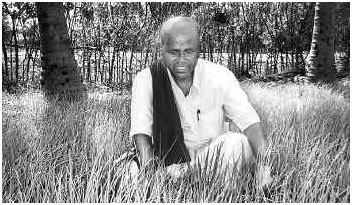
When grown with organic inputs, the crop developed deep roots and could withstand drought conditions.
COUNTRY ONION with large-sized bulbs can be harvested when raised with organic farming technologies. The onions will taste better and can stand long storage as well according to farmer-scientist, Mr.V.Antonysamy of Chintamani, Puliangudi in Tirunelveli district of Tamil Nadu.
He has successfully demonstrated an organic package for getting higher yields from country onions. He planted the onions in June-July season. About 1500 kg of bulbs were used to cover a hectare. The bulbs were planted in ridges and furrows thrown 40 cm apart, and the spacing between plants in a row was 15 cm.
The main field was thoroughly worked to remove all stubbles and stones and it was brought to a fine tilth by repeated ploughings. Liberal quantities of farmyard manure were incorporated with the final ploughing.
The field was irrigated immediately after planting, and the young sprouts showed up within a week. When the plants were about 15 days of age, the first manual weeding was done, and the earth was stirred up using a hand hoe. This facilitated better aeration for the root zone. Soon afterwards, the first spraying was done with fish ensilage, according to Mr. Antonysamy.
The fish ensilage was prepared by soaking 1 kg of marine fish in a 1 kg jaggery solution dissolved in 1 litre of water in an earthen pot. In about a month the fish decomposed in the fermented broth of jaggery as indicated by sweet smell.
The ensiling process takes only fifteen days in the case of inland fish. About 100 ml of the resultant liquid was diluted in 10 litres of water, and the suspension was sprayed on the crop, according to him. On the 30th day of planting, a second round of weeding was done, and at that time 3 per cent solution of Panchakavya was sprayed to make it grow luxuriantly. On the same day, about 10 tonnes of compost mixed with rice husk ash was broadcast over the entire field.
The field was copiously irrigated to soak in the nutrients. Subsequent irrigations followed at weekly intervals as dictated by the soil moisture regimen.
As a plant protection measure a botanical insect repellent was sprayed on the crop when it was 15 days old. The plant-based concoction called `Poochi viratti', was made by soaking equal quantities of leaves of Vitex negundo (Nochi), Calotropis gigantea (Erukkan), Nerium (Arali), Aloe vera (Sothu Kathazhai) and Pongamia pinnata (Pungam) in cow's urine for seven days in shade. The fermented liquid is diluted ten times in water and sprayed over the crop to repel sucking and chewing pests, according to him. To protect the crop from any fungal infection, Mr. Antonysamy sprayed it with a mixture of Aloe vera and country garlic pearls ground and soaked in water for 24 hours. This preparation was diluted in 200 litres of water and sprayed over the crop at monthly intervals starting from the 15th day of planting. Two more manual weedings on the 45th day and the 60th day were done.
The crop grew well, and was ready for harvest on the 70th day. The leaves turned yellow. The crop grown with organic inputs had developed deep, penetrating roots and could withstand drought conditions.
The crop was harvested manually, and a yield of 17.5 tonnes of bulbs was recorded from one hectare. The cost worked out to Rs.50, 000 per hectare, and he sold the crop at a rate of Rs.5 a kg, according to Mr. Antonysamy.
High yielding amla for high density planting |
|
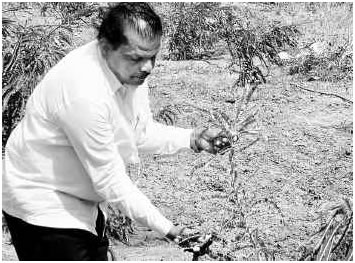
The innovative engineer in the high-density amla plantation raised in marginal land.
AMLA (INDIAN gooseberry or Nelli) is a hardy, drought tolerant crop, and it lends itself to high density planting even in marginal and wastelands. "Through systematic pruning techniques, the grafted trees of high yielding varieties can be retained as bushes of profuse bearing and such bushes are ideally suited for high density planting," says Mr. R. Kolandaisamy, an engineer-turned-farmer at Marungulam village near Thanjavur.
"High yielding amla varieties such as NA 7, Krishna and Chakia are particularly suited for closer planting with a spacing of 3 m by 3 m.
By adopting this spacing and following hexagonal or triangular method of planting as many as 1200 plants can be accommodated in a hectare.
Some shade-tolerant medicinal plants such as Phyllanthus sp (Keelanelli) and gulmeg can be grown as intercrop until the amla trees reach economic bearing age," explained this innovative and enterprising engineer.
Water management
In his 25-hectare organic farm integrated with high-tech nursery, he has laid a demonstration plot of 0.4 hectare with more than 400 grafts of high yielding varieties of amla. "Water management and special pruning techniques are crucial for its success. I have laid drip-system for the efficient discharge of water right at the root zone, and adopt the unique pruning to encourage lateral shoots for year-round profuse bearing and easy harvesting," points out Mr. Kolandaisamy.
Good quality and healthy grafts of the high yielding varieties were planted in well-prepared fields. Small pits of 30 cm by 30 cm by 30 cm were filled up with good organic manure, mulched with coir pith compost, neem cake and vermi-compost to increase the water holding capacity of the soil.
Biofertilizers such as Azotobacter, phosphobacterium and Vesicular Arbuscular Mycorrhiza (VAM) were applied regularly to boost the plant growth.
Initially, for the first three months, the drip-system was set to deliver 25 litres per plant per day (depending on the soil moisture regimen).
When the plants were established, the same quantum of water was used for irrigation on alternate days.
After the first year of growth, when the grafts have put down penetrating and extensive root systems, each plant would need only 25 litres once a week, that too in peak summer. The plants are systematically pruned, and fruiting can be noticed even in young plants.
However, economically viable and bigger fruits can be got from the third year of planting. Each plant will yield about 25 kg of fruits a year. When the trees are five years old, the yield per tree will gradually rise to 50 kg a year.
Cost per hectare
From the 8 th year onwards, the average output per tree will be about 100 kg a year, according to Mr. Kolandaisamy.
The cost of raising an amla plantation works out to Rs. 1.25 lakh per hectare. The returns from the third year of planting, at an average price of Rs. 10 / kg of fruits, will be about Rs. 2.5 lakhs.
Cultivation of medicinal plants as intercrops would provide returns till the amla comes to bearing and fetch assured returns. With sound management of natural resources and good varieties, we can make every square centimetre of our farm yield rich dividends," points out Mr. Kolandaisamy.
|
|






